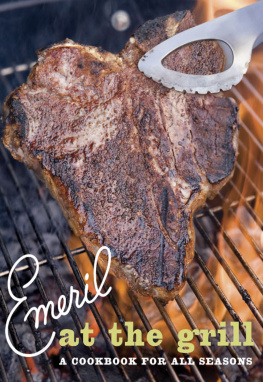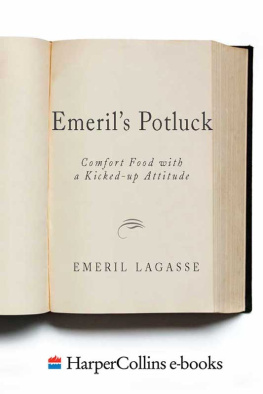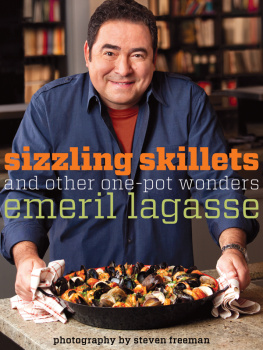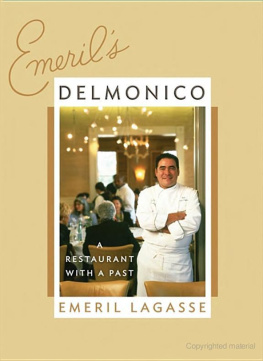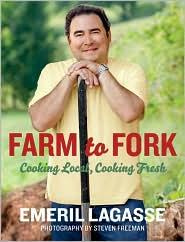
Australia
HarperCollins Publishers (Australia) Pty. Ltd.
Level 13, 201 Elizabeth Street
Sydney, NSW 2000, Australia
http://www.harpercollins.com.au
Canada
HarperCollins Canada
2 Bloor Street East - 20th Floor
Toronto, ON, M4W, 1A8, Canada
http://www.harpercollins.ca
New Zealand
HarperCollins Publishers (New Zealand) Limited
P.O. Box 1
Auckland, New Zealand
http://www.harpercollins.co.nz
United Kingdom
HarperCollins Publishers Ltd.
77-85 Fulham Palace Road
London, W6 8JB, UK
http://www.harpercollins.co.uk
United States
HarperCollins Publishers Inc.
10 East 53rd Street
New York, NY 10022
http://www.harpercollins.com
E MERILS NEW NEW ORLEANS COOKING
A t the forefront of an extraordinary culinary renaissance is Emeril Lagasse and his new book, Emerils New New Orleans Cooking. As chef-proprietor of New Orleanss award-winning restaurant Emerils, he fuses the rich traditions of Creole cookery with the best of Americas regional cuisines and adds a vibrant new palette of tastes, ingredients, and styles. The heavy sauces, the long-cooked roux, and the smothered foods that were the heart of old-style New Orleans cooking have been replaced by simple fresh ingredients and easy cooking techniques with a light touch. Now Emeril serves up a masterpiece in his first, and eagerly awaited, cookbook, Emerils New New Orleans Cooking.
He shares the recipes that have made his restaurant both a local favorite and a number-one destination for visitors to New Orleans. Start with Big Easy Seafood Okra Gumbo, Oysta Pasta with Caviar, and Spinach and Goat Cheese with Warm Andouille Dressing. Move on to Pecan-Crusted Lemonfish with Lemon Butter Sauce and Pecan Crab Relish, Piri Piri Chicken with Jcama Orange Salad, Carpetbag Steak with Tasso Hollandaise, or Emerils New New Orleans Paellayaan inventive combination of paella and jambalaya. Finish with lavish, decadent desserts including Emerils signature Banana Cream Pie with Banana Crust and Caramel Drizzles, New Orleans Goat Cheesecake, and Banana Chocolate Bread Pudding with Mint Crme Anglaise. No New Orleans cookbook would be complete without a chapter on Sunday brunch, and this one includes Crab Cakes with Tomato Mustard Coulis, Chicken Andouille Hash with Poached Eggs and Sauce Piquante, and a crowd-pleasing Smoked Salmon Cheesecake with Green Onion Coulis.
Beyond these hundreds of really easy-to-prepare recipes, Emeril offers plenty of professional tips, shortcuts, and useful information about stocking your own New Orleans pantry and making your own seasonings.
Emerils New New Orleans Cooking comes alive with more than one hundred photographs of the people and places that make New Orleans a one-of-a-kind town. With a one-of-a-kind chef.




F or T ari, J essica, and J illian
Emerils: That of, or belonging to, Emeril Lagasse, chef/proprietor of Emerils Restaurant, New Orleans.
J.T.

New: Made or become fresh; different from one of the same category that has existed previously.
W EBSTER

New Orleans: A city with a beguiling personality, a contagious warmth, an unaffected character whose people have a special genius for celebration.
M EL L EAVITT , A Short History of New Orleans

Cooking: Cookery, cuisine, culinary art.
R OGET

Contents
CHAPTER 1
Emerils Pantry: Basic Recipes and Basic Techniques
CHAPTER 2
New New Beginnings: Appetizers and Tantalizers
CHAPTER 3
Pot Food: Soups and Stews
CHAPTER 4
The New Italian Renaissance: Pasta and Risotto
CHAPTER 5
Greens and Other Colors: Salads and Dressings
CHAPTER 6
Midday Sunday: The Brunch Bunch
CHAPTER 7
By the Bayou: New New Seafood
CHAPTER 8
Fowl Play: Chicken, Duck, and Quail
CHAPTER 9
The New Meat Menu: Beef, Veal, and Lamb
CHAPTER 10
Pig Heaven: Pork
CHAPTER 11
Choosing Sides: Vegetables, Legumes, Potatoes, and Relishes
CHAPTER 12
Your Daily Bread: Breads, Breadsticks, Biscuits, and Muffins
CHAPTER 13
Sweet Revolution: Desserts

T heres a great mystique about New Orleans food, which may explain how I ended up here: I had to come and figure it out. Its flavor and substance are dominated by two distinctly different cooking styles: Cajun, which is the lusty, robust food of the Acadian farmers and fishermen in southwest Louisiana, and Creole, a more refined, cosmopolitan cuisine brought to this city by the early Europeans who emigrated here and their capable cooks. Both styles can be absolutely delicious, and both have been popular here for more than two hundred years. I call it Old New Orleans (hereafter referred to as ONO) food.
When I first arrived in New Orleans in 1983, everyone was eating ONO food, meaning wonderful but heavy Creole and Cajun delicacies such as baked, smothered oysters, shrimp remoulade, crabmeat ravigote, stuffed artichokes, thickly rouxed gumbos, fried fish meunire, crawfish touffe, and bananas Foster. I was the chef at Commanders Palace and my customers loved eating ONO. I did, too, but I soon grew bored and started experimenting with both the local palate and with the fresh local food products. Gradually I developed a repertoire of what I call New New Orleans (NNO) dishes: food whose roots are planted in a solid foundation of Creole heritage, but which has grown through exposure to other exotic cultures; Creole reinvented with an Oriental, Portuguese, or New Mexican flourish.
For instance, crawfish and Creole seasonings stuff both rellenos with red bean sauce and crunchy egg rolls with hot sesame dipping sauce; Louisiana andouille sausage dominates Italian gnocchi with spicy tomato sauce; fresh gulf fish goes Indian with curry-infused oil; and that old New Orleans standby, oysters Rockefeller, gets a total face-lift in Oysters in Pernod Cream with Fried Spinach. Ive stretched in every direction, seeking new methods, trying unexpected flavor combinations, rejecting gimmicksalways trying to be true to my adopted home, New Orleans. NNO food can be whimsical or serious, but its always delicious.





